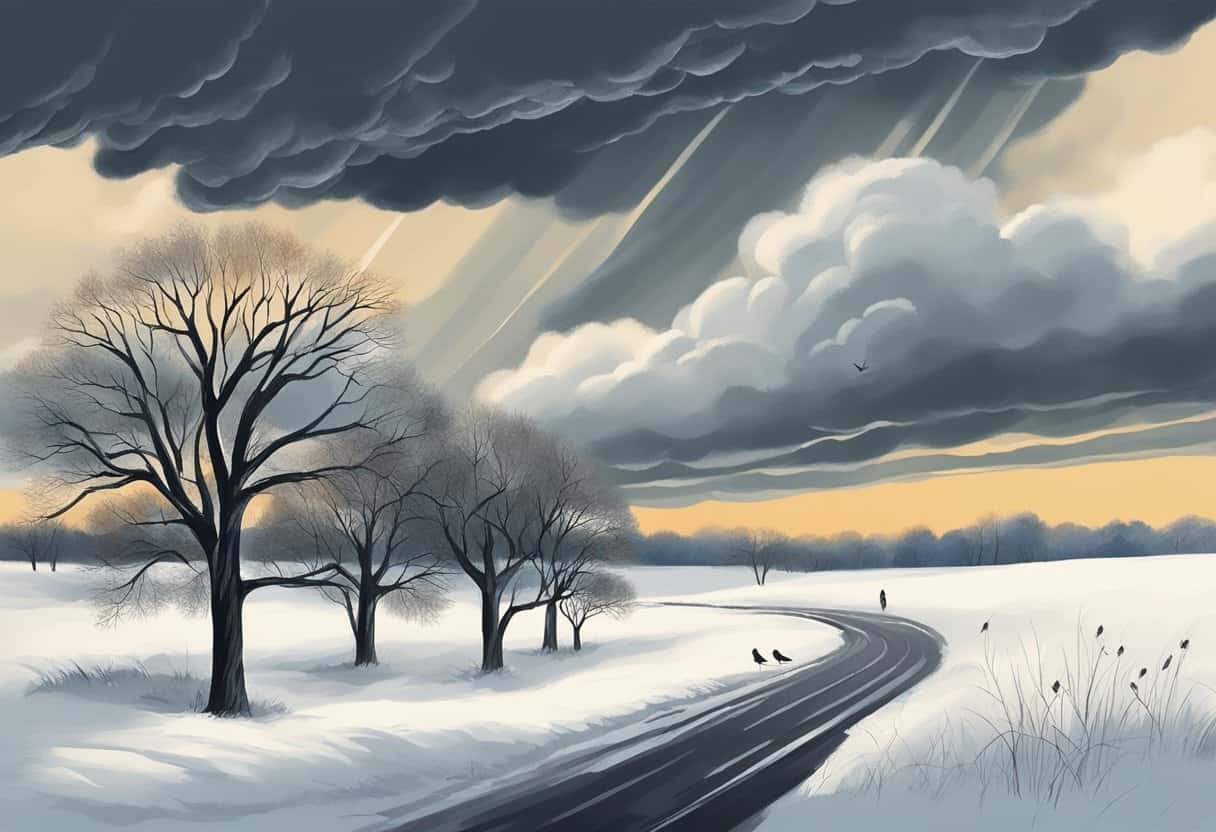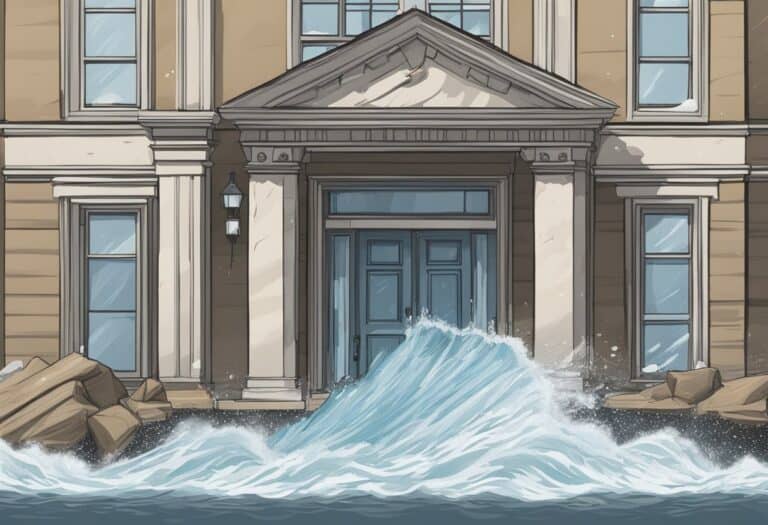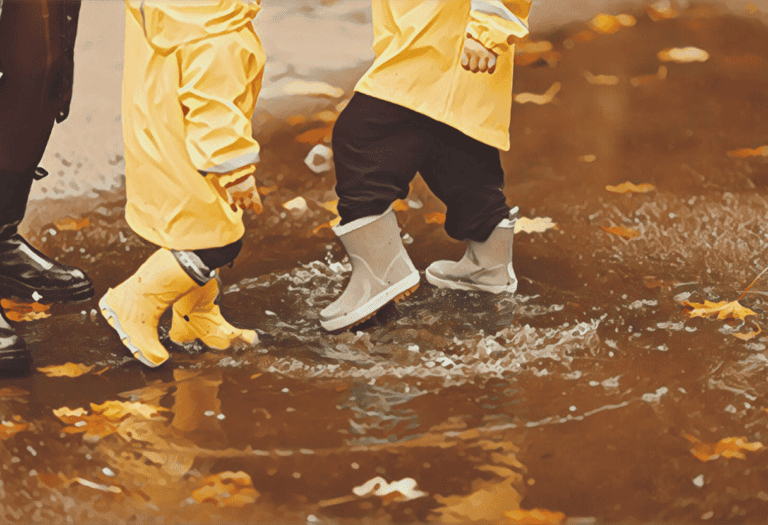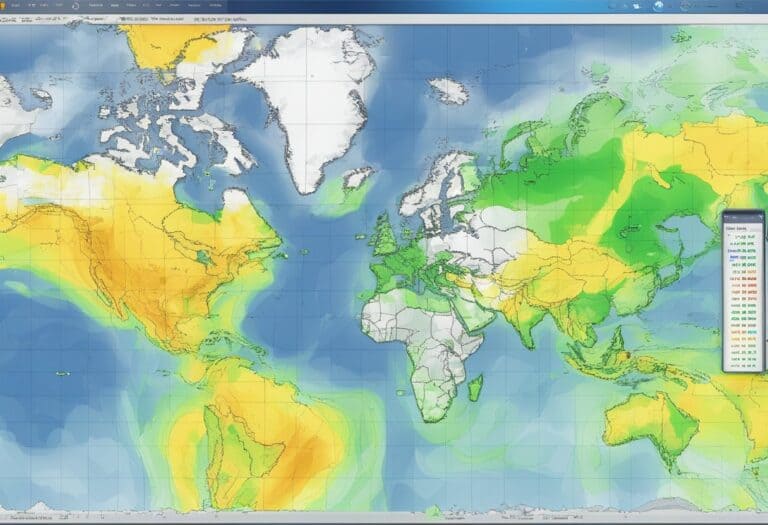Cold front weather is a meteorological phenomenon that significantly influences weather patterns, characterized by the leading edge of a cooler air mass replacing a warmer air mass.
This transition often results in a variety of weather conditions, from clear, brisk days to severe thunderstorms. Understanding a cold front’s fundamentals is essential, as it explains why weather changes so abruptly and how it can vary based on the season and region it affects.
The conditions surrounding a cold front are quite dynamic and can lead to an array of weather events that have a notable impact on daily life, agricultural practices, and even infrastructure. As a cold front moves in, you may experience a noticeable drop in temperature, changes in wind direction, and shifts in atmospheric pressure.
These changes can lead to the development of precipitation, thunderstorms, and, in some cases, severe weather events such as tornadoes, especially in the United States where cold fronts are common features that shape the country’s diverse climate conditions.
Cold fronts bring rapid weather changes, from temperature drops to severe storms, shaped by air mass contrasts. Key to safety and preparedness, their impact varies by region and season, influencing daily life, agriculture, and infrastructure. Understanding cold fronts is crucial for adapting to and mitigating their effects.
Cold Front Fundamentals
Understanding the basic principles of cold fronts is essential for grasping how they affect weather patterns. This section will give you comprehensive details about what exactly a cold front is and the characteristics it presents.
Definition and Formation
A cold front represents the leading edge of a cooler and denser air mass replacing a warmer one. When you encounter a cold front, you’re essentially experiencing this transition zone. Cold fronts form at the boundary of two contrasting air masses, where the colder air pushes beneath the less dense warmer air, causing it to rise, which can result in cloud formation and precipitation.
Characteristics of a Cold Front
When observing a cold front, look out for the rapid drop in temperatures and a swift change in wind direction. Often fronts can be preceded by clear signs, like towering cumulous clouds giving way to a clear and cold air mass. A typical forecast might predict swift, sometimes volatile changes in weather, such as a storm or clear skies following the front’s passage. The following table summarizes the main attributes of a cold front:
| Attribute | Description |
|---|---|
| Temperature | Expect a significant decrease as the front passes. |
| Air Pressure | Often rises sharply following the front. |
| Wind | Usually shift from southeast to northwest. |
| Clouds | Tall, cumulus clouds may form ahead of the front, often leading to precipitation. |
Cold Front Conditions
When a cold front passes through your area, you can expect significant changes in both temperature and wind behaviors. Being aware of these shifts is crucial for your safety and preparedness.
Temperature Changes
A cold front’s approach brings a noticeable drop in temperature, as it ushers in cooler air masses, often of arctic origins. Depending on the season and region, this transition can rapidly turn a warm day frigid within a matter of hours.
Wind Patterns and Wind Chill
With the arrival of a cold front, you’ll observe a shift in wind patterns. Winds typically swing around to come from the north or northwest, indicating the movement of the front. The increased wind speeds contribute to a significant wind chill factor, making the air feel colder than the actual temperature suggests. This can make outdoor conditions particularly harsh and can quickly lower your body temperature if you’re not adequately dressed for the situation.
Cold Front Weather Events

In cold front weather events, you’ll often witness significant shifts in weather patterns, including intense precipitation and unique winter weather phenomena. Understanding these events is crucial for preparing and responding appropriately.
Precipitation Patterns
Cold fronts are often associated with precipitation because they involve the movement of colder air mass under a warmer one, lifting the warm air. This process condenses the moisture in the air, leading to precipitation. The type of precipitation varies, but during cold front events, you typically see heavy rainfall. This study on frontal and precipitation structure provides insights into how these patterns can vary along a cold front’s passage.
Winter Weather Phenomena
As cold fronts pass, you can experience severe winter weather phenomena. Persistent cold air can create conditions suitable for heavy snowfall and even give rise to snow squalls—brief but intense snowfall that significantly reduces visibility and can create dangerous travel conditions. Additionally, winter storms may develop along a cold front, with the potential to produce blizzards and ice storms, particularly if the cold air is entrenched and deep. Knowledge of events like the southerly burster illustrates how cold fronts can be amplified by geography, leading to sudden and severe weather changes.
Cold Front Impact on the United States
When a cold front passes across the United States, it significantly influences weather patterns, with effects varying by region and season.
Regional Effects
Each region of the United States experiences distinct changes in weather due to cold fronts. For example, in the Southeast, the frequency and extent of summertime cold fronts can affect temperatures and precipitation (MDPI). These patterns shift with cold fronts, which can also trigger storms and cool spells.
Cold Front in the Midwest
In the Midwest, states like Nebraska and the Dakotas frequently confront cold fronts that can cause sudden drops in temperature and severe weather. For instance, you might observe a marked temperature decrease following a cold front, as shown in meteorological data from central United States stations (American Meteorological Society).
Great Lakes Weather Dynamics
The Great Lakes, including Lake Michigan, play a crucial role in modifying the weather from cold fronts. When cold air moves over the relatively warm waters of the lakes, lake-effect snow can result, especially on the leeward shores. Chicago and other cities near the Great Lakes may experience intensified winter weather due to this effect.
Cold Front Influence in the Northeast
As cold fronts head into the Northeast, major cities can expect dynamic changes. For example, the leading edge of a notable cold surge, like the one in March 1993, brought significant snowfall and a rapid drop in temperature across the region, deeply impacting states like Michigan, and extending even into Mexico and Central America (American Meteorological Society).
By understanding these regional variations and preparing for the expected weather changes, you can better navigate the impact of cold fronts in the United States.
Health and Safety Concerns
Exposure to cold front weather can lead to significant health risks, particularly frostbite and hypothermia. Understanding how to protect yourself against extreme cold is crucial for your safety.
Frostbite and Hypothermia Risks
When your skin and the tissues beneath it freeze, you are experiencing frostbite. Your nose, ears, cheeks, chin, fingers, and toes are especially vulnerable when exposed to the cold. In severe cold, particularly when the wind chill is low, risk of frostbite can occur in just minutes.
Hypothermia, on the other hand, happens when your body loses heat faster than it can produce it, causing a dangerously low body temperature. Early symptoms include shivering, fatigue, and confusion, and if not promptly addressed, it can become life-threatening. Both conditions are emergencies and require immediate medical attention.
Signs of Frostbite:
- Numbness
- Discolored skin (white or grayish-yellow)
- Hard or waxy-looking skin
Signs of Hypothermia:
- Shivering
- Slurred speech
- Clumsiness
Protecting Against Extreme Cold
To minimize health risks during a cold front, listen for wind chill warnings which are critical alerts that inform you about the risks of frostbite and hypothermia. Dressing in layers and keeping dry is essential. Use the following guidelines to fortify yourself against the cold:
Layer Up:
- Base layer (moisture-wicking fabric)
- Insulating layer (fleece or wool)
- Outer layer (wind and waterproof material)
Cover Exposed Skin:
- Wear hats, gloves, and scarves
- Use face masks to protect against windburn and frostbite
- Apply a skin protectant or moisturizer to minimize skin damage
Stay Dry:
- Avoid sweating or becoming wet as this increases the risk of hypothermia
- Change out of wet clothing as quickly as possible
Always be prepared by checking the forecast before going outdoors and carry a winter safety kit if traveling.
Meteorological Studies and Reports
In the realm of meteorology, your comprehension of cold fronts is enhanced by an array of studies and reports that focus on their characteristics and impacts. Precise knowledge of such weather phenomena is critical for day-to-day weather forecasting and understanding the dynamics behind these systems.
National Weather Service Alerts
The National Weather Service (NWS) issues alerts to keep you informed about the potential impact of cold fronts. These alerts include watches and warnings that can help you anticipate severe weather conditions. For instance, a Severe Thunderstorm Watch might precede the arrival of a cold front, indicating the potential for high winds and hail.
Weather Maps and Prediction Models
Weather maps, pivotal tools for meteorologists, visualize information about cold fronts, such as temperature differences and wind patterns. Prediction models take this data and simulate future atmospheric behavior. Programs like the Global Forecast System (GFS) incorporate observations to predict cold front movements and associated weather, aiding in the development of accurate forecasts.
Historical Weather Patterns
When you explore the history of weather patterns, particularly regarding cold fronts, you encounter numerous instances of significant meteorological events. Among these, record-breaking cold fronts are especially notable due to their impact on climate, ecosystems, and human activity.
Record-Breaking Cold Front Events
In studying record-low temperatures tied to cold fronts, you’ll find that arctic cold fronts play a pivotal role. For instance, historic cold front events have at times ushered in chilling temperatures that have shattered long-standing records. An example of such an event was the infamous arctic cold front in 1989 that led to the coldest temperature ever recorded in many locations across the United States.
- December 23, 1983: A memorable record-shattering cold front brought unprecedented cold to the Midwest, with temperatures plummeting to as low as -25°F.
- January 2019: A more recent event coined the “Polar Vortex” saw Midwestern temperatures drop to -38°F, demonstrating the extreme nature of arctic incursions.
These historical events underscore the power and unpredictability of cold front weather patterns. Your awareness of these occurrences helps you appreciate their significance in the history of weather recording.
Cold Front Management and Response
Effective management and response to cold fronts is crucial to mitigate their impact on communities, particularly regarding infrastructure preparedness and weather-related disruptions. Your awareness and preparedness can make a significant difference in ensuring safety and continuity during such events.
Infrastructure Preparedness
Your local infrastructure is designed to withstand various weather conditions, yet cold fronts can pose unique challenges. It is essential for power systems to be robust, as cold fronts often lead to increased energy demand. Websites like PowerOutage.us provide real-time data on electrical outages, which can be critical for emergency response teams and citizens to monitor and prepare for potential power disruptions.
Emergency response protocols must be in place to ensure swift action when infrastructure is compromised. This includes maintaining clear roads for the transit of emergency vehicles and pre-deployment of resources to vulnerable locations. For your individual preparedness, it is advised to have an emergency kit ready, inclusive of necessary supplies to last several days.
Weather-Related Disruptions
Cold fronts can lead to a multitude of weather-related disruptions that require careful planning and response. Transportation networks, for example, are often affected by icy conditions. You should stay informed on the latest weather updates and advisories to avoid unnecessary travel.
Furthermore, safety measures and guidelines should be followed closely during these times. Authorities often issue guidelines for protecting your home and family, which may include steps like insulating pipes to prevent freezing. In terms of emergency response, having contact information for local services at hand and understanding your community’s emergency plans are critical actions you can take.
Environmental Context
When you consider cold front weather, the complex interplay between atmospheric phenomena and the broader implications of climate change play a pivotal role. Understanding this context is crucial for anticipating and interpreting weather patterns.
Climate Change Influence
Climate change is having an unmistakable impact on weather systems around the globe, leading to more pronounced and unpredictable weather events. Evidence suggests that the warming climate, driven by increased greenhouse gases, is modifying the characteristics of cold fronts. Environment Canada has noted that, as the Arctic warms, the temperature gradient that drives the formation of cold fronts may be altered.
- Frequency: You might observe shifts in how often cold fronts occur.
- Intensity: The severity of weather associated with cold fronts, including wind and precipitation, could be heightened.
- Seasonality: Changes in the timing of cold fronts throughout the year are possible, potentially disrupting historical weather patterns.
These shifts in cold front characteristics can have a range of ecological and socio-economic impacts, emphasizing the importance of ongoing research and monitoring by institutions like Environment Canada. Stay informed on the latest findings to better understand how your local weather might be influenced by global climate trends.
Technical Aspects of Cold Fronts
The technicality of cold fronts involves precise measurements and data reporting which are pivotal for accurate weather predictions. You’ll need to understand how these complex meteorological phenomena are tracked and characterized by institutions such as the National Oceanic and Atmospheric Administration (NOAA).
Measuring and Reporting
When measuring cold fronts, experts employ a variety of instruments to capture wind speed, wind direction, and temperature changes, usually in Fahrenheit. This data contributes to comprehensive surface analysis, enabling meteorologists to monitor cold fronts accurately.
Wind is a critical factor to measure as a cold front approaches:
- Wind Speed is usually reported in miles per hour (mph) or knots (nautical miles per hour).
- Wind Direction is indicated in degrees or as cardinal directions (e.g., N, NE, E, SE, etc.).
Temperature drops are significant and rapid, with sleet or lake-effect snow potentially occurring if conditions are right. Measurement tools include thermometers for temperature and anemometers for wind, among others.
Your local weather stations and the NOAA perform rigorous surface analyses, plotting these conditions on weather maps. Such maps indicate fronts, pressures, and precipitation, providing visuals that denote the movement and characteristics of cold fronts. When you read these maps, you’ll notice symbols indicating fronts, with cold fronts often represented by a line with triangles pointing in the direction the cold air is moving.
Understanding these technical aspects can assist you in anticipating weather changes and preparing accordingly for the potential impacts of a cold front, such as a significant temperature drop and increased wind activity.
Frequently Asked Questions
Gaining insight into cold front weather conditions helps you to better understand and prepare for shifts in your local climate.
What conditions are typically experienced with the passage of a cold front?
When a cold front passes, you may experience a noticeable drop in temperature, strong winds, and often a line of precipitation, which might include heavy rain or thunderstorms.
How does a cold front affect local weather forecasts?
Your local weather forecast will likely predict cooler temperatures and possible severe weather alerts when a cold front is approaching, as these systems are capable of producing weather extremes.
What distinguishes a cold front from other types of weather fronts?
A cold front is defined by a leading edge of cooler air displacing warmer air, typically moving from northwest to southeast, which contrasts with warm fronts that move warm air over cold air, often more slowly and with different weather patterns.
How can one interpret the approach of a cold front on a weather map?
On a weather map, you can identify a cold front by the blue line with triangles pointing in the direction of travel. Changes in pressure, wind patterns, and temperatures around this symbol help you detect the front’s approach.
What are the general directional movements associated with cold fronts?
Cold fronts generally move from northwest to southeast, but their path can be influenced by the jet stream’s orientation and other atmospheric conditions.
How do cold fronts impact weather patterns in regions like Texas?
In regions like Texas, cold fronts can lead to dramatic weather changes, including sharp drops in temperature and the potential for severe thunderstorms, especially during the transition seasons of spring and fall.







